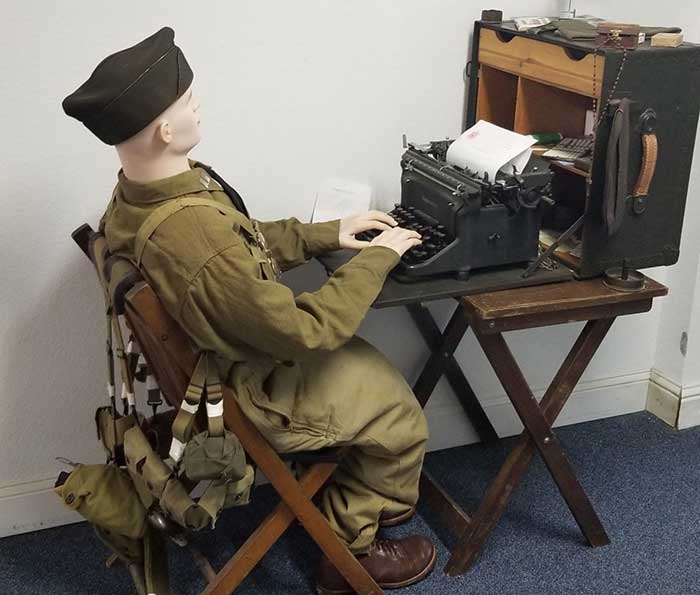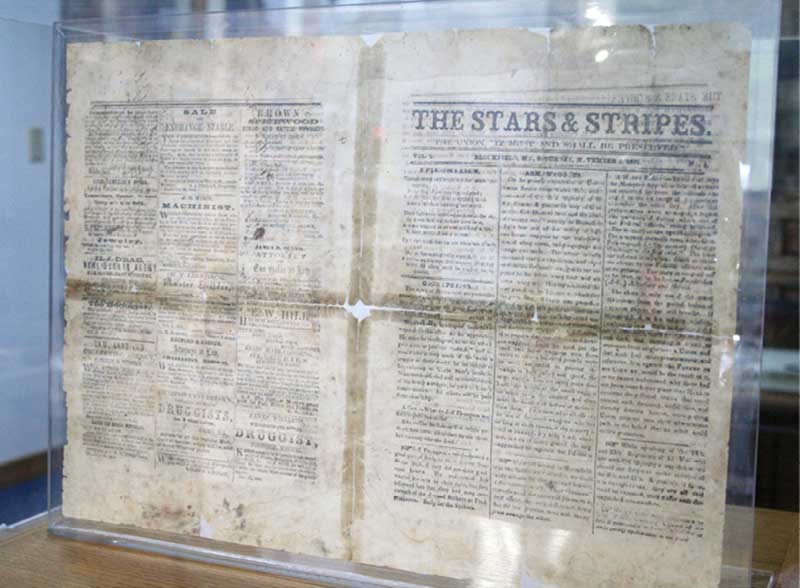For more than 160 years, Stars and Stripes has told the stories of the US military.
It began on November 9, 1861, when Union soldiers under the command of Colonel Oglesby entered Bloomfield in pursuit of Confederate Brigadier General Jeff “Swamp Fox” Thompson. The town, including the newspaper office, was empty. Ten Union soldiers entered the newspaper office and printed a newspaper about the war effort. That was the start of a publication that continues to tell the military story in various theaters around the world.
Found in an Indiana attic and one of only five known copies, a first edition issue is on display under protective plastic at the The National Stars and Stripes Museum and Library in Bloomfield.
During the Civil War, there were at least five independent military publications with the name Stars and Stripes, says museum administrator Laura Dumey. There were two in Thibodaux, Louisiana, and two in Jacksonport, Arkansas, in addition to the one in Bloomfield. The non-Missouri editions were printed on wallpaper, due to a newsprint shortage.
The Missouri Stars and Stripes was printed only once during the Civil War. It wouldn’t see publication again until World War I, when it was an eight-page weekly. Publication stopped after WWI, then for the first nine months of World War II, it was restarted.
Since the first Stars and Stripes was printed in Bloomfield in 1861, the Department of Defense designated Bloomfield as the birthplace of the Stars and Stripes newspaper.

After World War II, the newspaper kept publishing, although Congress, which oversees the publication, threatened unsuccessfully to cease printing it in 2020. It has been a daily publication since January 1943.
The on-site library contains more than forty thousand issues of the newspaper. People may bring an iPad or borrow one from the museum to do digital research of the newspaper’s archives. Today’s issues include both print and digital versions.
The museum has twenty-six thousand items in its collection, and the rotating exhibits cover the Civil War, both World Wars, Desert Storm, the Korean Conflict, the Vietnam War, and modern activity.
In front of the museum sits a helicopter that has the look of being in flight and a cannon. On the southern part of the property near the memorial cemetery sits a barn that includes a World War II barracks. It houses a Deusenhof troop carrier truck and a Dodge command car. Additionally, a curved wall was added to the landscape in 2000. It includes memorial names, supporting businesses, Stars and Stripes alumni, and area citizens who served.
Past exhibits have featured displays of Civil War Union and Confederate soldiers, the US Army Nursing Corps, a collection of model airplanes from various wars, a Battle of the Bulge scene, a teletype machine, a typesetter’s lead letters case, a World War II Jeep, and a diorama of soldiers wearing the Stars and Stripes correspondent patch among other items.
Stars and Stripes hires military and civilian journalists to produce various editions for specific wartime theaters.
“We have a video available that tells of the world’s most dangerous paper route,” Laura says, the delivery of the paper in active war zones around the world. Another exhibit at the museum, The Cost of Covering War, memorializes Stars and Stripes staff who died in the line of duty.
Visit NSSML.org for more information.

Related Posts
A Warrensburg Gem
Step backward in time at the McClure Archives and University Museum in Warrensburg.
Inside Jefferson City’s Museum of Modern Art
Opened in October 2015, the Jefferson City Museum of Modern Art features the works of Purvis Young, Thornton Dial, and Abdoulaye Diarrassouba, better known as Aboudia. All have earned national and international acclaim for their art, which can be found in some of the country’s most distinguished museums.



